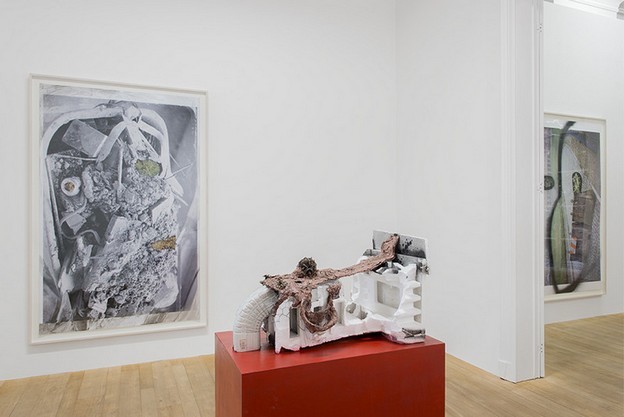Wages of Fear
09 Oct - 05 Dec 2015
WAGES OF FEAR
Huma Bhabha
9 October - 5 December 2015
For her first exhibition with the gallery, Huma Bhabha will present a group of new works that further the artist’s longstanding study of the relationship between the reclaimed materials of the present and our cultural and historical experience of the past. This particular series of works on paper, photo-collage, and sculpture, ranging explicitly in material, finds coherence in continued references to the detritus of modern human construction, such as urban landscapes, utopian architecture, and figure-based monuments. In a gesture that represents Bhabha’s more intimate perception of modern detritus, several works exchange overt formal relationships with one another, indicating the certain confluence of objects that have been produced under the restraints and close proximity of the artist’s studio.
As is customary to her practice, three sculptures, while comprised of widespread materials that at times include cork, Styrofoam, tire, nail polish, pinecones, acrylic paint, clay, and aluminum, are distinctly different in form and content. In one, Road to Balkh, a rubber tire is unraveled and laid out atop a clay base with a rough armature of gridded wire. Though the sculpture has a markedly contemporary presence, the title refers to the ancient city of Balkh, which today exists as a small,
industrial town, still echoing its influential past through the presence of its ruins, located in the region of northern Afghanistan. But here, the futuristic image of post-apocalyptic urban remains is retroactively embodied via the inoperable tire, which is at once stunted in its original purpose while also indicating a modern-day advance that the ruins now face with a dismal contrast.
The works on paper share a unique relationship to the surrounding objects in the show. Each acts as an archive of residual cork dust from the production of sculptures at the artist’s studio that has collected into the patterned, overlapping reliefs of footprints along a brick floor. The irregularly sliced edges of the paper heightens the awareness of their transfer of utility in an act that refers back to Bhabha’s interest in sourcing materials designed to fabricate, if not signify, the
physical production of the modern world. As with the defunct and repurposed material that the ruins of Balkh have come to endure, these large sheets of seamless paper, previously serving different practical ends, are now exemplary of the potential shifts in material perception over time.
Huma Bhabha (American, b. Karachi, Pakistan, 1962) has been the subject of solo exhibitions at MoMA PS1, New York; Collezione Maramotti, Reggio Emilia, Italy; the Aspen Art Museum, Aspen; and The Aldrich Contemporary Art Museum, Ridgefield, USA, amongst others. Recent group exhibitions include America is Hard to See at the Whitney Museum of American Art, New York; All the World’s Futures, 56th Venice Biennale, Venice, Italy; Land Marks, The Metropolitan Museum of Art, New York, USA; 2010 Whitney Biennial, New York, USA; and the 7th Gwangju Biennale, Gwangju, South Korea. She currently lives and works in Poughkeepsie, New York.
Huma Bhabha
9 October - 5 December 2015
For her first exhibition with the gallery, Huma Bhabha will present a group of new works that further the artist’s longstanding study of the relationship between the reclaimed materials of the present and our cultural and historical experience of the past. This particular series of works on paper, photo-collage, and sculpture, ranging explicitly in material, finds coherence in continued references to the detritus of modern human construction, such as urban landscapes, utopian architecture, and figure-based monuments. In a gesture that represents Bhabha’s more intimate perception of modern detritus, several works exchange overt formal relationships with one another, indicating the certain confluence of objects that have been produced under the restraints and close proximity of the artist’s studio.
As is customary to her practice, three sculptures, while comprised of widespread materials that at times include cork, Styrofoam, tire, nail polish, pinecones, acrylic paint, clay, and aluminum, are distinctly different in form and content. In one, Road to Balkh, a rubber tire is unraveled and laid out atop a clay base with a rough armature of gridded wire. Though the sculpture has a markedly contemporary presence, the title refers to the ancient city of Balkh, which today exists as a small,
industrial town, still echoing its influential past through the presence of its ruins, located in the region of northern Afghanistan. But here, the futuristic image of post-apocalyptic urban remains is retroactively embodied via the inoperable tire, which is at once stunted in its original purpose while also indicating a modern-day advance that the ruins now face with a dismal contrast.
The works on paper share a unique relationship to the surrounding objects in the show. Each acts as an archive of residual cork dust from the production of sculptures at the artist’s studio that has collected into the patterned, overlapping reliefs of footprints along a brick floor. The irregularly sliced edges of the paper heightens the awareness of their transfer of utility in an act that refers back to Bhabha’s interest in sourcing materials designed to fabricate, if not signify, the
physical production of the modern world. As with the defunct and repurposed material that the ruins of Balkh have come to endure, these large sheets of seamless paper, previously serving different practical ends, are now exemplary of the potential shifts in material perception over time.
Huma Bhabha (American, b. Karachi, Pakistan, 1962) has been the subject of solo exhibitions at MoMA PS1, New York; Collezione Maramotti, Reggio Emilia, Italy; the Aspen Art Museum, Aspen; and The Aldrich Contemporary Art Museum, Ridgefield, USA, amongst others. Recent group exhibitions include America is Hard to See at the Whitney Museum of American Art, New York; All the World’s Futures, 56th Venice Biennale, Venice, Italy; Land Marks, The Metropolitan Museum of Art, New York, USA; 2010 Whitney Biennial, New York, USA; and the 7th Gwangju Biennale, Gwangju, South Korea. She currently lives and works in Poughkeepsie, New York.

